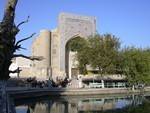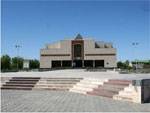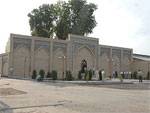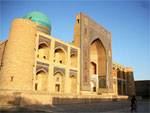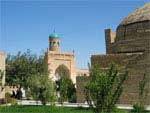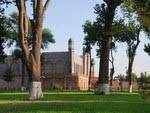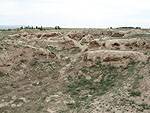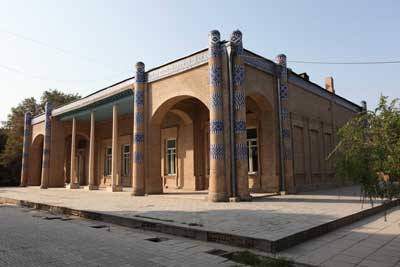Pearl of East: Your travel guide in Uzbekistan.
|
Main Menu
Tashkent
Samarkand
Bukhara
Khiva
Baysun
Nukus
Margilan
Ferghana
Nurata
Namangan
Kokand
Sarmysh Say
Termez
|
News / НовостиUzbekistan: Historical monuments: yesterday and today28/06/2015 19:52 Gain knowledge, learn a trade, prices them, Then they, too, will appreciate you. Yusuf Hos Hodjib
Amazing buildings and unique monuments of ancient Khorezm still amazes visitors with its magnificence. They were created by the skillful hands of masters ("Ustoz"), whose names remain forever in history. Pictures centennial history of Khiva is reviving in front of us the name of the famous Khiva master of stone carving, artist, builder Ruzmata Masharipova, who was born in the late 19th century in Khiva. His childhood was spent in workshops, where he studied with his Ustoz already taken place. Some time later, he learned all the skills of his craft and became known as master Ruzmat. He was revered as a skilled builder and the artist's designs. That is why he was appointed chief foreman during the construction of the northern gate of Dishan Kala (outer city) and Kush Darvoza (Twin Gate). In 1912, by order of Isfandiyar Khan (1910-1918) master Ruzmat worked with masters Khudaiberganov Hodge, an artist on the ornament Nurmatov, Kuryazom nicknamed "Chakkon" (ie fast, "handyman"), and other Babakhan Bola masters ganch carving and wood in the construction of the receiving room in the palace Nurullabaya Dishan Kala. Referring to historical sources for the construction of this architectural monument, then we knowthat the Vizier Said Khan Islam Khodja by order of Khan appointed his chief disciple Rahimbergena Makhramah construction. In the book, Professor O.A.Abdullaev "Medicine in Khorezm" has the following lines: "Islam Khodja went to Moscow and visited the mayor's reception N.I.Guchkova. Guchkov introduced vizier Islam Khodja a Moscow architect A.M.Ropa." While the architects of Moscow led by Rop arrived in Khiva and agreed with local craftsmen hospital project, the telegraph, the hotel for the reception of ambassadors. Soon the projects were ready, and began construction. For the construction of the hotel for ambassadors were used a special firing bricks in 1911-1913. Claywas took to the village Avaz Dunak, located near the town, and then subjected to a special processing clay and fired in a 4 kiln. The firing of bricks,master Babadjan, master Humbuz, Matyaz bola, Hassan pirsiyan (Persian), Babakhan Kuriyos and others attented. The roof of the palace was covered with thin sheets of iron in the form of a triangle. In the palace, there are 7 rooms, doors, windows and parquet flooring which were made by German craftsmen from Akmechet (the name of the village, located 15 km. From Khiva). The interior of the rooms of the palace rooms Foster different from each other. Ganch on the walls and ceiling were made by master Ruzmat Arbob Masharipov, Nurmat Usta, Hudaibergan Hodji,Kuriyos Babadjan and others. A painting executed under the direction of master Vaisyoz Matkarimov: they painted the walls with carvings oil paint. Images of flowers and angels on the ceiling was made in the European style by Russian masters. The Muslim religion forbids portraying angels, people, so permission for this was obtained from the Grand Vizier, father-in-Khan, Islam Khodja. Islam Khodja was an educated man of his time, a man of advanced ideas. The second living room, had a size of 8h14 m, 6 m high, was intended for feasts, the fourth room served as a waiting room of Khan, which were concluded and signed the contract. The diameter of this room, which had an octagonal shape of the circle, is 10 m., The height of 7 m. During the reign of Khan, there was the size of one mirror 1,5h3m in every corner of this room. The ceiling of the room was made of wood, expertly decorated with beautiful geometric patterns and gilded. The decoration of the ceiling was involved by Khiva master Kalandar Babacan, Masharif Kalandar, Vaisёz Matkarimov and others. From the base of the ceiling on the walls were installed undulating cornices, which imported from Russia in wrapped in a special paper form. At the center of the ceiling of the room is a depiction sixth simvola- Muslim crescent and stars on all four sides of the ceiling were caused oil painting to depict angels by Russian masters. As a result, the design of one room was used the symbol of Muslim and Christian religions. On the ceiling of the room depicts the seventh peacock feathers inlaid with various precious stones. Carvings on the walls were covered with bronze paint and striking in its beauty. For heating Khan's Palace in winter were brought seven earthenware stoves from Russia. These ovens were made of solid slabs by Russian masters. For heating was used saksaul. Another novelty in the Khan's Palace was electric lamps (lamps) for the living room, also imported from Russia. Since they were very heavy and large, the roof of the palace were equipped with special wooden device in the form of pyramids. They attached chandeliers. For lighting and electricity in the palace of Khiva was brought a small engine capacity of 16 horsepower. To activate the first light bulb in Khiva was invited by the master Musa Sabanovich Yangiurazov from Syzran, a city on the Volga River,. For the construction of the treasury Foster spent 70 thousand gold coins (126,000 soums). To participate in the construction of the master (Master) Ruzmat came to the attention of Khan. Han rewarded Ruzmata generously for his studio work and called him "master of masters" ("Arbob") Since that Ruzmata became known Ruzmat Arbob. Khan invited him to participate in the construction of the Summer Palace Qibla Tozabog ("South Garden") and Orca Tozabog ("Northern garden"), he expressed confidence in the master. The whole life of master was devoted to the construction, but it is not only built, but also participated in the repair and reconstruction work. In the book, the late historian Komila Abdullayev, who has devoted her memory of his father Abdullah Boltaeva, "Life, inscribed in the pattern" a lot of warm words were written about the master Ruzmate Arbob, according to information from the book, in 1930-1935-ies, master Ruzmat Arbob restored destroyed together with other newly many historical monuments in Khiva (Kunya Ark, the palace Tashhauli (1936-37)). For example, "Notable in Khiva masters were often visited, I listened very carefully to their conversations. In one of these conversations master Ruzmat Arbob told a story about how one day walked out of the house (he lived near Ota House) and saw as the left side of madrassas Qutlugh monk collapsed kiln. It was a time when the war started. In local government had no money for repair madrassas. Ruzmat Arbob maked good business: he led reconstruction work to restore madrassas. All the masters agreed to participate in this really. When I was in the museum, I saw working there Ruzmat Arbob Jumanazarov and his son (the master had one son, who was drafted into the army. And after some time came the news of his death). The father said that the bricks for oven Ruzmat Arbob bought at his own expense." Skill Ruzmata Arbob Masharipova was worthy of praise. Because even in the 60 years of age, he was involved in repair work madrassas Pakhlavan Mahmud. Shattered pieces were shown in their original condition. Dome sparkled with all the colors and was fine as before. All the greatness and beauty of the ancient city are reflected in this beautiful monument. |
Calendar
Weather
Useful Links
Searching for Airways and Hotels
|


